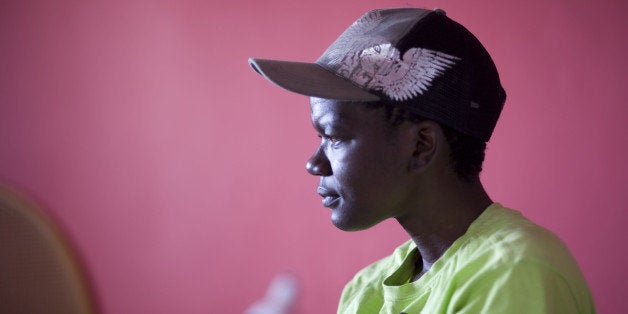
The South African Constitution is arguable one of the most progressive constitutions in the world, for innumerable reasons, but for the purposes of this blog post, I want to focus on the fact that Section 9, Subsection 3 specifically prohibits discrimination against people on the basis of their sexual orientation.
In a lot of constitutions around the world, sexual orientation is not explicitly stated as grounds for protection from discrimination. It is simply assumed to be constitutionally protected. But in the South African Constitution, it is an explicit, enumerated basis for protection.
The problem, though, is that there seems to be a gap in South Africa between the legal realm and the sociocultural realm. And in this gap appears the phenomenon known as "corrective" rape. Corrective rape is a phenomenon wherein a homosexual person is raped as a means of "correcting" their sexual orientation. In most cases, the victims are black lesbians. This phenomenon takes place in other countries as well, but for the purposes of this post I'm focusing on South Africa.
The New York Times published a very informative op-ed on individual cases of corrective rape, titled "The Brutality of Corrective Rape." In this interactive piece, writer Clare Carter highlights rape victims and survivors who were attacked because of their sexual orientation:
In one of the few cases to attract press attention, in 2008, Eudy Simelane, a lesbian, was gang-raped and stabbed to death. Her naked body was dumped in a stream in the Kwa Thema Township outside Johannesburg. A soccer player training to be a referee for the 2010 FIFA World Cup, she was targeted because of her sexual orientation.
In another infamous case of corrective rape in South Africa that occurred in 2011:
Noxolo Nogwaza, 24, was raped, and stabbed multiple times with glass shards. Her skull was shattered. Her eyes were reportedly gouged from their sockets.
In South Africa most cases of corrective rape are against black lesbians, and I'm going to analyze this phenomenon in the context of a post-apartheid South Africa deeply embedded in a culture of heteronormativity. I read a very enlightening article by Megan Morrissey in the journal Womyn's Studies in Communication, which talks about the discourse among black South Africans around corrective rape. In the article Morrissey discusses the common argument from black Africans that the practice of homosexuality is un-African, something brought about during colonization.
Many people quoted and interviewed in the article state that homosexuality is exclusive to the white man and his culture. By distancing black African culture from homosexuality, these people marginalize black gay Africans from their own culture. There is a further alienation of black lesbians, who would only be allowed back into the larger culture if their non-normative sexual orientation changed. So men subject these womyn to corrective rape as a "rite of passage" back into the culture, because they believe that this act would force these womyn to "submit," become heterosexual, and assume their "proper" role in society.
According to Megan Morrissey:
[S]eated at the center of these episodes of sexual violence is an intense desire to reclaim an authentic South African identity that foregrounds strength, heterosexuality, and what are perceived to be traditional South African gender roles, rendering the body of the Black lesbian powerless within a culture recovering from years of violent colonial rule and apartheid.
In South Africa, homosexuality is associated with white culture, and because of the years of apartheid rule, there exist tensions between black and white cultures in South Africa. Homophobia and violence, in the form of corrective rape, is a means to marginalize the white culture and regain a nationalistic identity that they believe was stolen from them due to years of colonization and apartheid.
Corrective rape is thus, on a very general level, a post-colonial and post-apartheid reaction to the white culture in South Africa. This explanation does not excuse their actions, but is does trace the violence back to the source. The question is: What next? The reason that corrective rape has persisted is that there has been a cultural, social, and even legal normalization and acceptance of the practice.
In an article on OSISA.org, it was reported that over 31 incidents of corrective rape in South Africa have led to the death of the victim, and of those 31 cases, only two have resulted in convictions. As for the act of corrective rape itself, according to the article, 10 new cases of corrective rape occur every week. Despite these staggering statistics, the attackers never really face any legal ramifications. Legal normalization, coupled with social tolerance and cultural acceptance, means the persistenc of corrective rape in South Africa.
It is further argued in the article on OSISA:
For South Africa to truly be a haven for equal protection under the law for all of its citizens, clear signals need to be sent that "corrective" rape is a crime that the government takes seriously.
Corrective rape is a crime against persons because of their sexual orientation, and since sexual orientation is a protected category in the South African Constitution, corrective rape should be regarded as a hate crime. There are different facets of the problem that need to be addressed with respect to corrective rape, which include the social, cultural, and legal facets.
There needs to be a cultural and social resocialization and subsequent normalization of homosexuality in South Africa, and the first step toward ensuring that the citizens accept non-normative sexuality is to show that the state supports it. To do that, the state needs to provide legal and political recourse for victims and survivors of corrective rape in South Africa.
